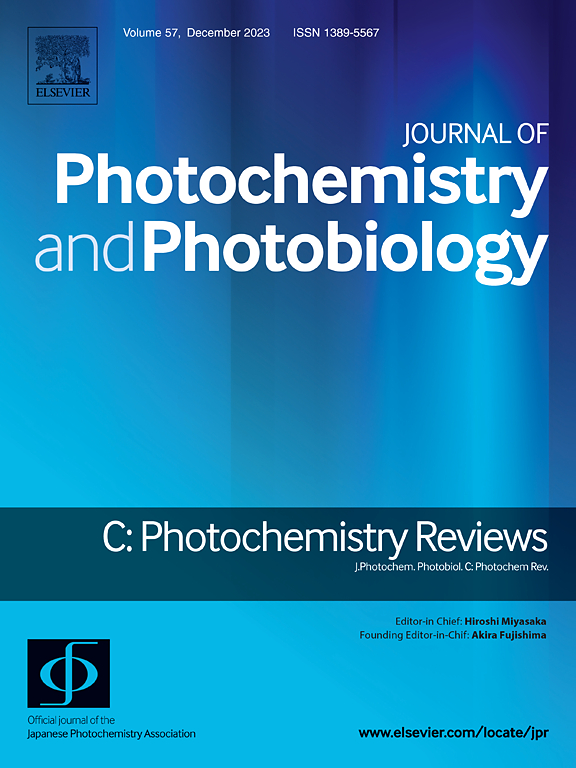Band gap engineering of tungsten oxide-based nanomaterials
IF 13.1
1区 化学
Q1 CHEMISTRY, PHYSICAL
Journal of Photochemistry and Photobiology C: Photochemistry Reviews
Pub Date : 2024-11-28
DOI:10.1016/j.jphotochemrev.2024.100681
引用次数: 0
Abstract
A band gap energy, a fundamental property of semiconductors, governs both their electrical and optical behaviors. When aiming to utilize semiconductors with tailored physical properties for specific applications, such as optoelectronic or photovoltaic devices, or as photoelectrodes in photoelectrochemical cells, there is often a need to adjust the energy band gap of the semiconductor. In this review, we have provided a comprehensive overview of various techniques employed for band gap determination. Noteworthy methods include UV-Vis diffuse reflectance spectroscopy (UV-Vis DRS) using the Tauc method, photoelectrochemical spectroscopy with external quantum efficiency measurements, spectroscopic ellipsometry (SE), photoluminescence (PL) spectroscopy, and photoacoustic (PA) spectroscopy. This article also offers an overview of extensive investigations undertaken to develop and characterize WO3-based nanomaterials with enhanced photoactive properties. Our exploration specifically delved into WO3 nanomaterials doped with various elements, encompassing alkali metals, nonmetals, transition metals, noble metals, and lanthanides. The scrutiny involved a meticulous analysis of these nanomaterials, considering their morphology and properties, while taking into account the intricacies of the applied synthesis methods. Additionally, our focus extended to the determination of band gap values and the exploration of practical applications of these WO3-based nanomaterials, aiming to provide a comprehensive understanding of how these materials can be employed in diverse technological domains, from photovoltaics to catalysis and beyond. The multifaceted nature of WO3-based nanomaterials positions them as promising candidates for advanced applications, and our exploration seeks to contribute valuable insights into their potential functionalities and performance across various fields.
氧化钨基纳米材料的带隙工程
带隙能是半导体的基本特性,它支配着半导体的电学和光学行为。当目标是利用具有定制物理性质的半导体用于特定应用时,例如光电或光伏器件,或作为光电化学电池中的光电极,通常需要调整半导体的能带间隙。在这篇综述中,我们提供了用于测定带隙的各种技术的全面概述。值得注意的方法包括使用Tauc方法的UV-Vis漫反射光谱(UV-Vis DRS),采用外部量子效率测量的光电化学光谱,光谱椭圆偏振(SE),光致发光(PL)光谱和光声(PA)光谱。本文还概述了开发和表征具有增强光活性特性的wo3基纳米材料的广泛研究。我们的探索特别深入到掺杂各种元素的WO3纳米材料,包括碱金属、非金属、过渡金属、贵金属和镧系元素。审查包括对这些纳米材料的细致分析,考虑到它们的形态和性质,同时考虑到应用合成方法的复杂性。此外,我们的重点扩展到带隙值的确定和探索这些wo3基纳米材料的实际应用,旨在全面了解这些材料如何应用于不同的技术领域,从光伏到催化等。wo3基纳米材料的多面性使其成为先进应用的有前途的候选材料,我们的探索旨在为其在各个领域的潜在功能和性能提供有价值的见解。
本文章由计算机程序翻译,如有差异,请以英文原文为准。
求助全文
约1分钟内获得全文
求助全文
来源期刊
CiteScore
21.90
自引率
0.70%
发文量
36
审稿时长
47 days
期刊介绍:
The Journal of Photochemistry and Photobiology C: Photochemistry Reviews, published by Elsevier, is the official journal of the Japanese Photochemistry Association. It serves as a platform for scientists across various fields of photochemistry to communicate and collaborate, aiming to foster new interdisciplinary research areas. The journal covers a wide scope, including fundamental molecular photochemistry, organic and inorganic photochemistry, photoelectrochemistry, photocatalysis, solar energy conversion, photobiology, and more. It provides a forum for discussing advancements and promoting collaboration in the field of photochemistry.

 求助内容:
求助内容: 应助结果提醒方式:
应助结果提醒方式:


